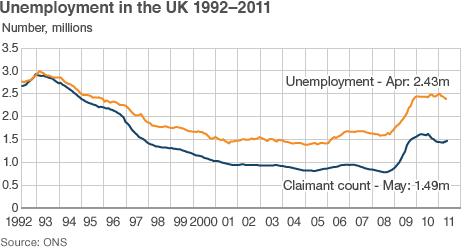UK unemployment total falls sharply
- Published
John Philpott from the Chartered Institute of Personnel and Development says there is a strong possibility unemployment will rise again
UK unemployment fell 88,000 in the three months to April this year to 2.43 million, the biggest drop since the summer of 2000, latest data shows.
The unemployment rate was 7.7%, according to the Office for National Statistics (ONS), external, down from 7.9% in the previous quarter.
However, the number of people claiming Jobseeker's Allowance in May rose by 19,600 to 1.49 million.
The rise was the biggest since July 2009, and larger than expected.
"The economy created more than half a million jobs over the last year," said BBC chief economics correspondent Hugh Pym.
"So even after the public sector shed just over 140,000 posts, total employment was still well ahead over twelve months."
The official unemployment figure - which is based on a survey - has been falling in recent months.
In contrast, the claimant count - which has now risen for the third month in a row - has been telling a much more downbeat story about the state of the jobs market.
However, analysts caution that some of the rise in the claimant count may be attributable to changes in benefits rules, which have seen many people move off other kinds of benefits onto the Jobseeker's Allowance.
Public versus private
The number of people who left unemployment during the quarter was almost matched by the number who entered new jobs, according to the latest ONS survey data.
The employment total increased by 80,000 to 29.24 million.
Employment minister Chris Grayling hailed the data as "very encouraging", and told the BBC that it showed the private sector was creating jobs much faster than the public sector was losing them.
Over the course of 12 months to the first quarter of this year, private sector employment rose by 520,000, while the public sector cut numbers by 143,000, leaving left total employment up by about 376,000.
But shadow employment minister Liam Byrne told the BBC: "When you look beneath the headlines, it turns out that most of those jobs were created last year, and the private sector is now creating jobs at a much slower pace.
"The number of vacancies is down, and we've still got three regions in Britain where unemployment is... going up quite significantly.
"A year and a half after the recession ended, that's just not good enough."
The unemployment rate fell most rapidly in Northern Ireland, down 0.8 percentage points to 7.2%, and Wales, down 0.7 percentage points to 7.9%.
In both Scotland and England, the rate fell only slightly, to 7.7%.
But within England there was considerable regional variation, with the North West, East and South West also all seeing more people out of work.
Chartered Institute of Personnel and Development chief economist John Philpott said underlying the jobs figures was "quite a sad story for many people and hard times still to come".
Many were trading down to find jobs, while those in work were seeing their incomes squeezed, he added.
The level of cuts already seen "indicates that the scale of public sector job cuts is going to be quite substantial, because we haven't yet had the full impact of the government spending cuts", he said.
TUC head Brendan Barber agreed that the UK labour market was "still very fragile and a long way off the level of jobs we had before the recession".
Nonetheless, he welcomed the apparent fall in youth unemployment. The jobless rate among 16 to 24-year-olds fell from 20.7% to 19.4%, according to the ONS.
Subdued wages
The latest data also revealed that earnings growth slowed in the three months to April, with earnings excluding bonuses up just 2% on a year ago - its slowest rate since last August.
It follows figures on Tuesday showing that the UK inflation rate remained at 4.5% in May, and is expected to rise further, implying that the real purchasing power of average wages is being steadily eroded.
"The fact that workers can't push for higher wage increases in this difficult economic environment means that real wages are going to continue to struggle," said Peter Dixon, economist at Commerzbank.
Employment minister Chris Grayling: "The private sector is creating jobs much faster than the public sector is losing them"
"I think that is one factor which will act against a sharp pick up in consumer spending. And without a pick up in consumer spending, it's very difficult to see how we are going to get a major rally in [growth] going forward."
The pound fell half a cent against the dollar following the data release, to $1.63, while the FTSE 100 index also dropped slightly.
"The market is reacting to the claimant count number and the wages data which are weaker than expected," said Amit Kara at UBS.
Analysts say that the subdued rate of wage growth reduces the chance that the Bank of England will raise interest rates this year, which in turn makes the pound less attractive on currency markets.
